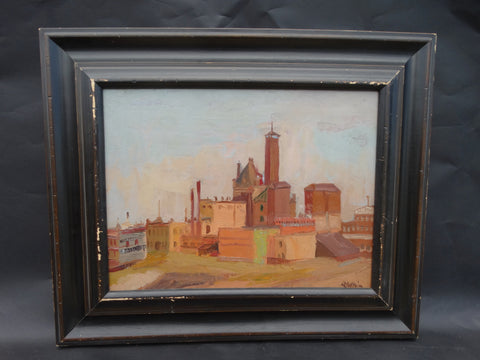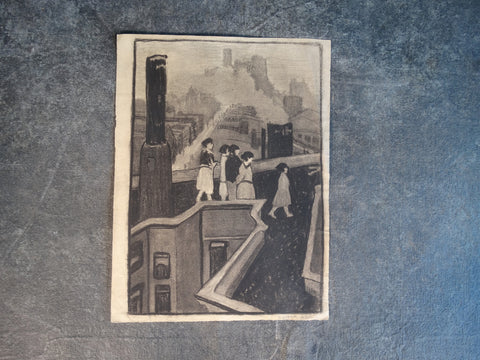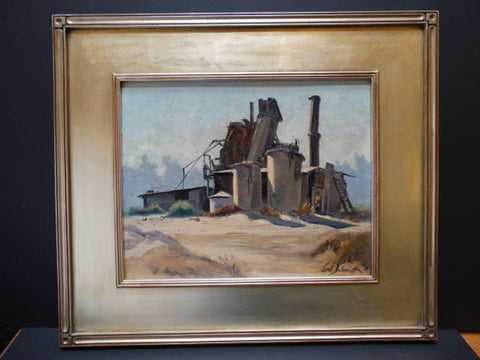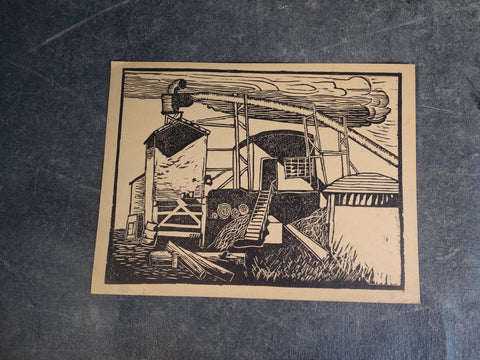Bertram Walter Priestman R.A. [1868-1951] View of a Northern Town, probably in Yorkshire P467
A masterly oil study (circa 1910) of the outskirts of a manufacturing town in the North of England, possibly Bradford or Sheffield, by Bertram Walter Priestman, one of the most highly regarded painters in his time by his fellow artists. A painter’s painter. Possibly a study for his first acknowledged masterpiece, “Outskirts of a Northern Town”.
Oil on board. Art measures 15" x 9.5".
Frame 21.25" x 15.75"
Bertram Priestman R.A.
by Nicholas Bowlby
From Antique Collecting magazine, June 1985
Bertram Priestman was born in Bradford, Yorkshire, in 1868. He first exhibited at the Royal Academy in 1889, and from that time until his death in 1951 he gained a reputation as one of the most eminent painters of his time.
He was elected a Royal Academician in 1923, exhibited alongside Corot, Degas and Boudin at the Goupil Galleries in 1909, was described as the “finest sky painter of our day” by Sir Frank Brangwyn, and is represented in the national collections of Canada, Hungary and Ireland amongst others, as well as in New South Wales and numerous municipal and private collections throughout the world. Yet today he is hardly known. Contemporaries of his such as William Nicholson, Wilson Steer, Walter Sickert and Orpen are sought after by collectors. But Priestman seems to have been passed by.
The major reason I believe to be quite simple. Very few of his works have come on to the market in recent years, and those that have have not done him justice. Although labelled as a “landscape” painter, Priestman was never a specialist, and it is impossible to make a judgement on him as an artist with only one or two paintings as evidence, hence the large number of illustrations in this article (which are arranged in chronological order).
Sir Frederick Wedmore wrote in his essay on Priestman in Some of the Moderns, published in 1909 — “Priestman may paint again, in fat prairies, the wandering or ruminating kine. Very likely. And no good judge of modern Art would have reason to be sorry for it. But I know that he is certain to paint again — to paint with ever increasing interest, and at least with nothing less than his present quietly possessed mastery — the harbour and the ship, the bridge and the canal boat; where, in mid-storm in some hollow or bottom the trees give shelter from the wind, and the grey church nestles. Nor can he stop painting — for he paints with a zest altogether apparent — the great marine horizons, the cloud borne up from the West, the stretch of dreary waters, and as it bears down on the victim shore it so entirely possesses, the force and gathered impetus of the sea.”
Priestman, possibly more than any other painter of his generation, was able to capture the voluminous light and life of the English countryside and coast and, revelling as he did in the exercise of free flowing line provided by oil paints, he produced some marvellously atmospheric paintings. In the modem desire for pictures that represent an idealised and often sentimental depiction of rural life, Priestman’s work stands as a virile and incorruptible standard by which to judge them.

![Bertram Walter Priestman R.A. [1868-1951] View of a Northern Town, probably in Yorkshire P467](http://earlycal.com/cdn/shop/products/P467-1_1024x1024.jpg?v=1510175071)
![Bertram Walter Priestman R.A. [1868-1951] View of a Northern Town, probably in Yorkshire P467](http://earlycal.com/cdn/shop/products/P467-1_grande.jpg?v=1510175071)
![Bertram Walter Priestman R.A. [1868-1951] View of a Northern Town, probably in Yorkshire P467](http://earlycal.com/cdn/shop/products/P467-2_grande.jpg?v=1510175072)
![Bertram Walter Priestman R.A. [1868-1951] View of a Northern Town, probably in Yorkshire P467](http://earlycal.com/cdn/shop/products/P467-3_grande.jpg?v=1510175072)
![Bertram Walter Priestman R.A. [1868-1951] View of a Northern Town, probably in Yorkshire P467](http://earlycal.com/cdn/shop/products/P467-4_grande.jpg?v=1510175073)
![Bertram Walter Priestman R.A. [1868-1951] View of a Northern Town, probably in Yorkshire P467](http://earlycal.com/cdn/shop/products/P467-5_grande.jpg?v=1510175074)



